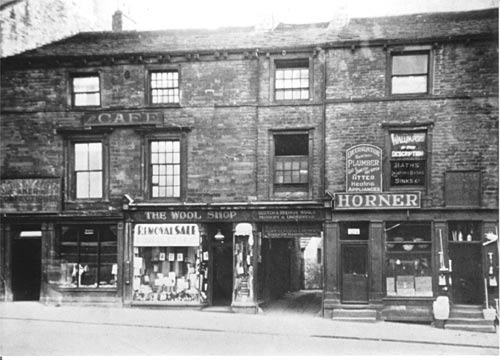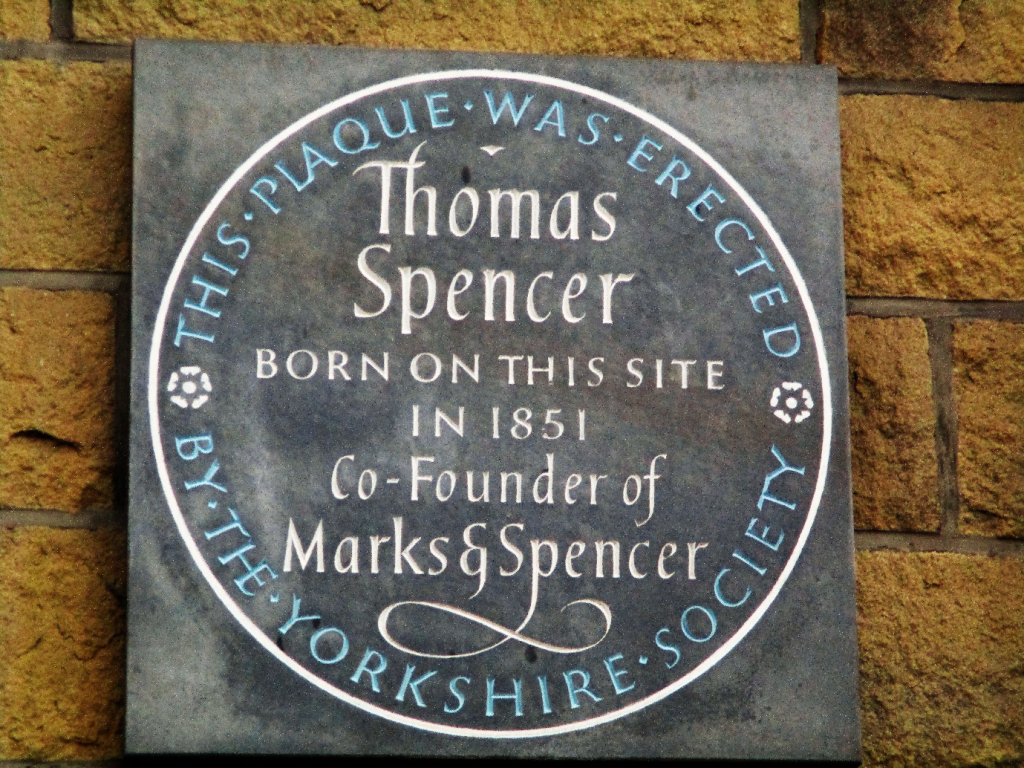By Brian Stott
Our town of Skipton has had some notable residents over the years, but how many of the current citizens of the town are aware that one of their former townsmen had a major influence on the shopping habits of our entire country. It would be fair to say that probably all of the country has shopped at some point in their lives in Marks and Spencer. So what is the connection to our town?
November 7, 1851 was a momentous day in the history of British Business. On this day Thomas Spencer was born in Queens Court Skipton in what then would have been the West Riding of Yorkshire. https://familysearch.org/ark:/61903/1:1:2N7Q-NRD
This is a picture of Queens Court in late 1800’s. It was at the bottom end of High street in the region of Yorkshire Trading Company.

I was brought up in Skipton from early 1960’s and I can remember a Painters and Decorators shop called Foster Horner which was where the Betfred Bookmakers now stands so it appears that the entrance to Queens Court was this tunnel.
There is a plaque on the wall near to Yorkshire Trading Company commemorating Thomas Spencer’s birthplace. How many people notice this as they go about their shopping in Skipton?

It is strange that the site was occupied for many years by Woolworths who were major rivals to M&S for most of the 20th century.
The plaque can be seen between Savers and Yorkshire Trading (Formerly Woolworths).

There are two Thomas Spencers aged 9 on the 1861 Census listed as living in Skipton. One is a Cotton Piecer so working in a mill as Child Labour and the second is a scholar. So it is probable he was still at school.
There isn’t a record I can locate of where he was educated, however, I attended Ermysted’s School in town and there was never ever any mention that Thomas Spencer was an illustrious “Old Boy” so it must be assumed that he was educated only in what would have been the local primary school.
Thomas Spencer graduated from his beginnings in Skipton to be the “Spencer” of the British Icon Marks and Spencers.
The story of Marks & Spencer’s remarkable success began in the 1890s when Michael Marks, a Polish Jew, joined forces with local man Thomas Spencer – a cashier.
Marks was working for a company in Leeds, called Barran, which employed refugees. An associate of his called Isaac Jowitt Dewhirst lent Mr Marks £5 which he used in 1884 to establish his Penny Bazaar on Kirkgate Market, in Leeds. It would have looked something like this artist’s impression.

Marks had little English when he arrived in Britain and received some assistance from Dewhirst to help him with his business. But the most important contribution made by Dewhirst to the firm’s success was when he introduced him to Skiptonian Thomas Spencer, his cashier, who was known as an excellent book-keeper.
Marks began renting a permanent stall in Leeds’s covered market, Kirkgate, in 1894 and invited Spencer to become his partner. Next to the stall was a poster with the words ‘Don’t Ask the Price, It’s a Penny.’
The partnership started in 1894 and cost Thomas Spencer £300 for a half-share of the business.
Thomas must have already been relatively wealthy from his role with Isaac Dewhirst as in today’s equivalent money this would have been £14,400.
The running of the business was split between Spencer, who managed the office and warehouse, and Marks, who continued to run the market stalls. Spencer had developed some important contacts while working for Isaac Dewhirst and these allowed him to get the best prices for goods by dealing directly with the manufacturers. Together, Spencer and Marks were able to open stores in Manchester, Birmingham, Liverpool, Middlesbrough, Sheffield, Bristol, Hull, Sunderland and Cardiff.
A new warehouse in Manchester was built in 1897. This store became the centre of a business empire that by then included thirty-six branches. New stores had been built in Bradford, Leicester, Northampton, Preston, and Swansea. London had a total of seven branches.
These photographs are of the first store in Leeds after they moved from the outdoor stall.

In 1903, Marks & Spencer became a limited company. Spencer’s original £300 investment had grown to a value of £15,000 and he retired later that year. In today’s monetary value this was in the region of £850,000 so a massive increase on his original investment in 7 years.
Sadly Thomas died in 1905 aged only 54 but his legacy lives on. His second wife Agnes (his first wife Elizabeth died in 1881 before the partnership with Marks) lived until she was 98 in 1959 and saw the massive growth of her husband’s company. She was a great supporter of charity with the Agnes Spencer Charitable Trust which is still active today as in this example http://www.teesvalleyfoundation.org/news/marks-spencer-connection-to-foundations-newest-fund/
Skipton despite being his hometown didn’t have a branch of his famous company until 2007 and this is in fact only a Food Hall outlet. There is a full branch at Keighley and this has been there since the early days.





